Meet 14 Animals Discovered in 2023
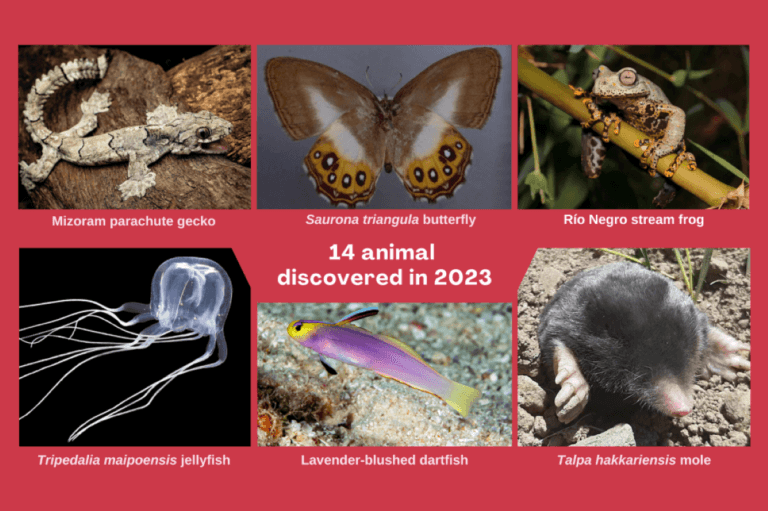

Written and verified by the biologist Georgelin Espinoza Medina
There are about 1,499,858 species in the Animal kingdom, grouped into 34 phyla, 110 classes, 686 orders, 9501 families, and 160,271 genera. And although the numbers may seem impressive, you may be surprised to know that new species are added to the list every year. Do you want to discover some of the animals that were discovered in 2023?
In 2022, researchers at the Natural History Museum in London described 351 new creatures, including beetles, moths, worms, bumblebees, wasps, reptiles, amphibians, and fish. Below, we’ll bring you 14 amazing specimens that humans have named for the first time this year. Let’s get to know them in the following list.
1. Snail-eating snake (Pareas baiseensis)

Among the animals discovered in 2023 is a snake belonging to the family Pareidae, which includes four genera, including Pareas, with the greatest diversity of specimens. Its discovery took place on the Asian continent, in the Guangxi Zhuang Autonomous Region of China.
This event was published in the journal Animals, in July 2023. The habitat of the new species is the subtropical evergreen broadleaf forest, between 750 and 790 meters above sea level, where four individuals (one male and three young) were found.
The morphological differences between the species that make up the genus Pareas are very subtle, so they’re difficult to distinguish from one another. Because of this, molecular analyses are indispensable for this purpose.
The snake Pareas baiseensis has a slender body with an elongated head and a round snout. The dorsal part is yellowish brown, with dark brown spots, while the ventral region is lighter, with some black speckles. It has irregular black bands on the sides. Also, it has a greater number of ventral and subcaudal scales than other relatives.
2. Patkai green tree frog (Gracixalus patkaiensis)
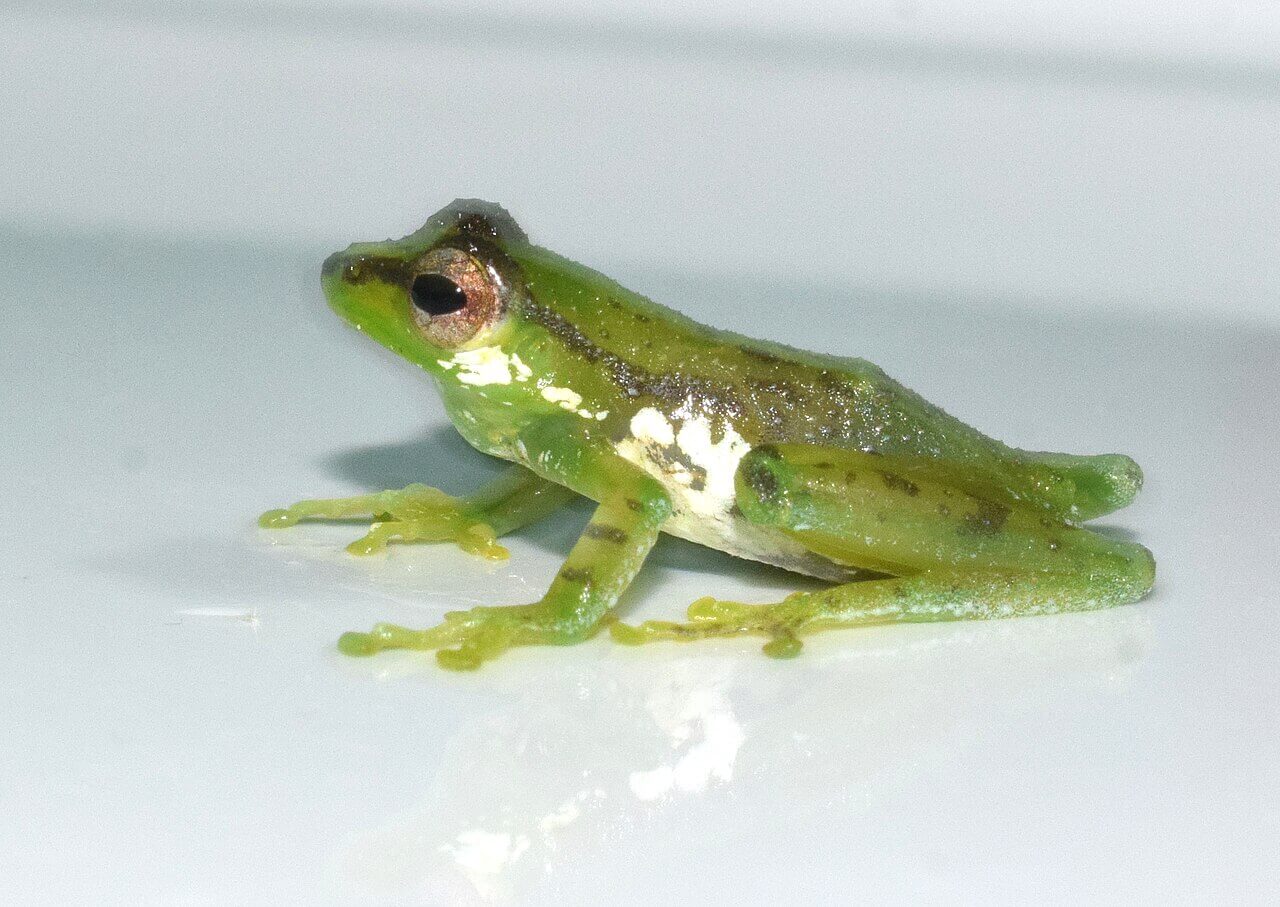
Gracixalus patkaiensis is a species of frog that belongs to the family Rhacophoridae, which was discovered in an evergreen forest in northeastern India at an elevation of 2126 feet above sea level.
The evidence for this discovery, published in the journal Vertebrate Zoology was based on the following characteristics:
- Physical
- Acoustic
- Molecular
This tree frog has a pointed snout and a slender green body with brown spots of different sizes. Its limbs are also elongated, and it doesn’t have membranes on its toes. It’s also very small, measuring between 23.6 and 26.5 millimeters in length.
It’s the first rhacophoridae frog found in India, and the word patkaiensis refers to the Patkai hill range. Therefore, the popular name suggested by researchers is Patkai green tree frog.
3. Aritana’s brown four-eyed possum (Metachirus aritanai)
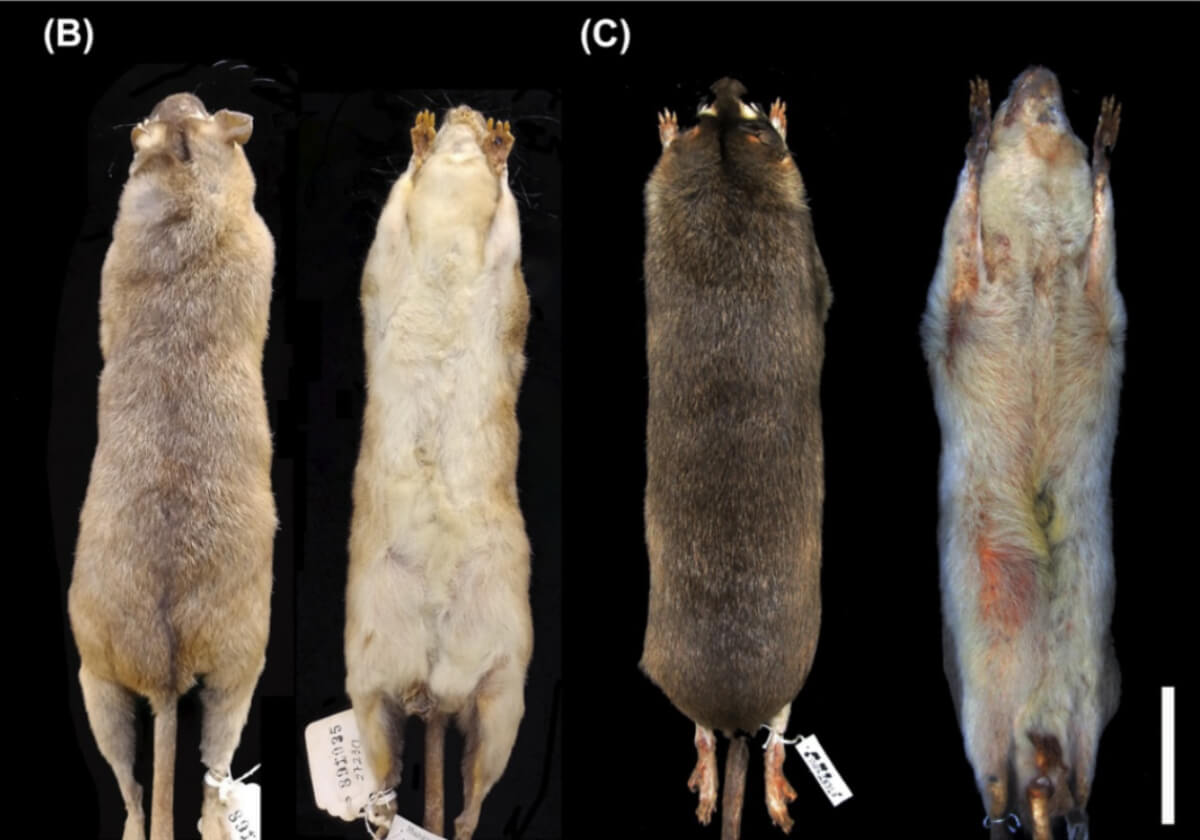
Another animal discovered in 2023 is a brown four-eyed opossum or jupati. It belongs to the genus Metachirus, which consisted of only one species and five subspecies, although during the last few years, it has been analyzed in greater depth to clarify its taxonomy.
Therefore, a study published in the journal Mammalia describes a new specimen from the Serra de Carajás, in Brazil, with the scientific name of M. aritanai, in honor of an indigenous leader of the Yawalapiti ethnic group, named Aritana.
This opossum is found in the interfluve of the Xingu and Trocantis rivers, but its exact distribution isn’t fully defined. Among its characteristics are the following:
- A cream-colored ventral area
- A broader and more robust head
- Light brown dorsal coloration mottled with gold.
They were given the name four-eyed opossums thanks to some spots present above their eyes that, in this case, are cream-colored.
4. One of the most fascinating animals discovered in 2023: The Saurona triangula butterfly
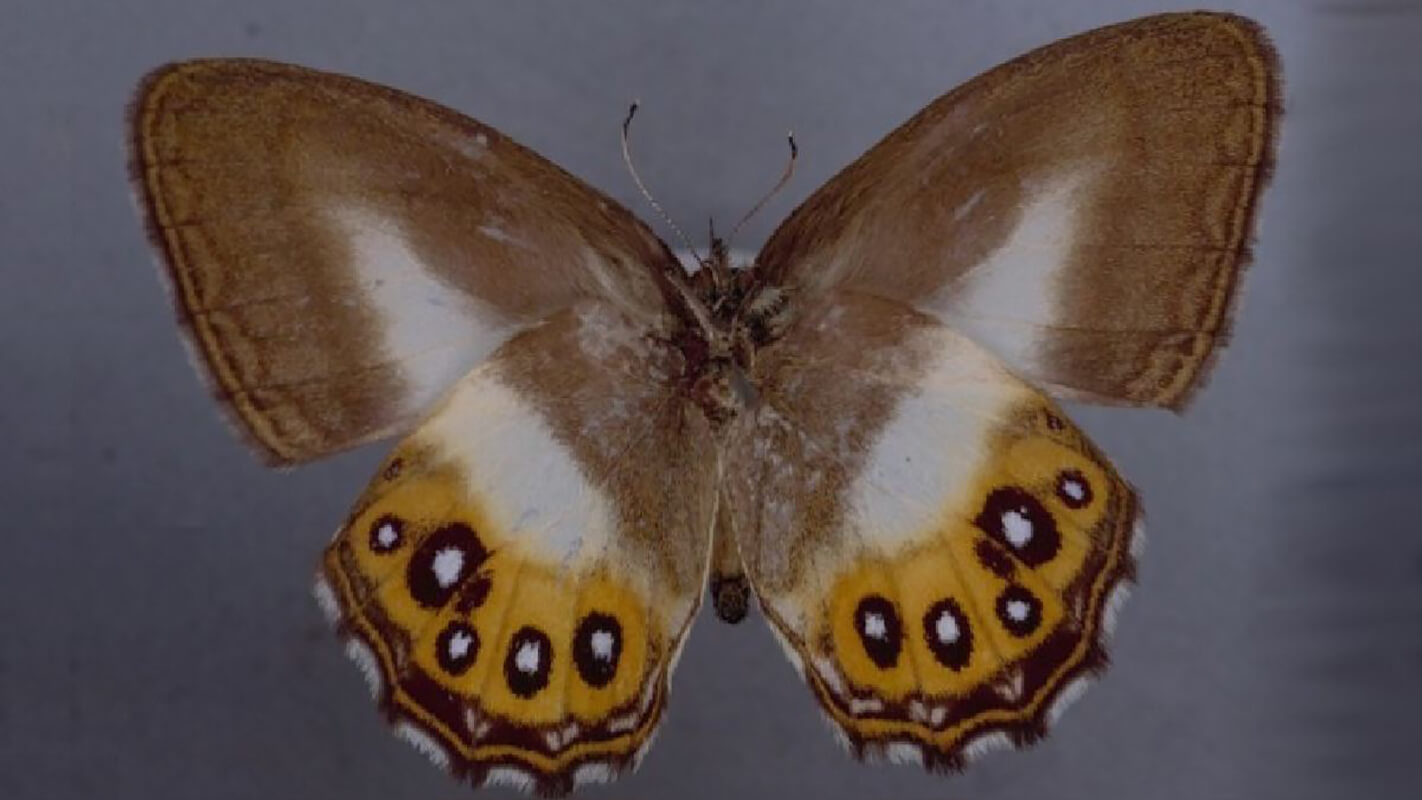
Named after the villain of the Lord of the Rings trilogy, Sauron, we have one of the insect-like animals discovered in 2023. It’s the butterfly Saurona triangula, found in the lowland rainforest of the southeastern Amazon in South America.
This species has brown wings with five black ocelli on each side. These are circular with large central silver pupils surrounded by orange scales.
Therefore, the name of this animal is thanks to its resemblance to the fiery eye of Sauron.
A researcher at the Natural History Museum in London gave the name to the genus, which has only two species: S. triangula and its relative S. aurigera. It’s also important to mention that there’s little data on its biology, as neither the immature stages nor the host plants are known. The study was published in the journal Systematic Entomology.
5. Mizoram’s parachute gecko (Gekko mizoramensis)
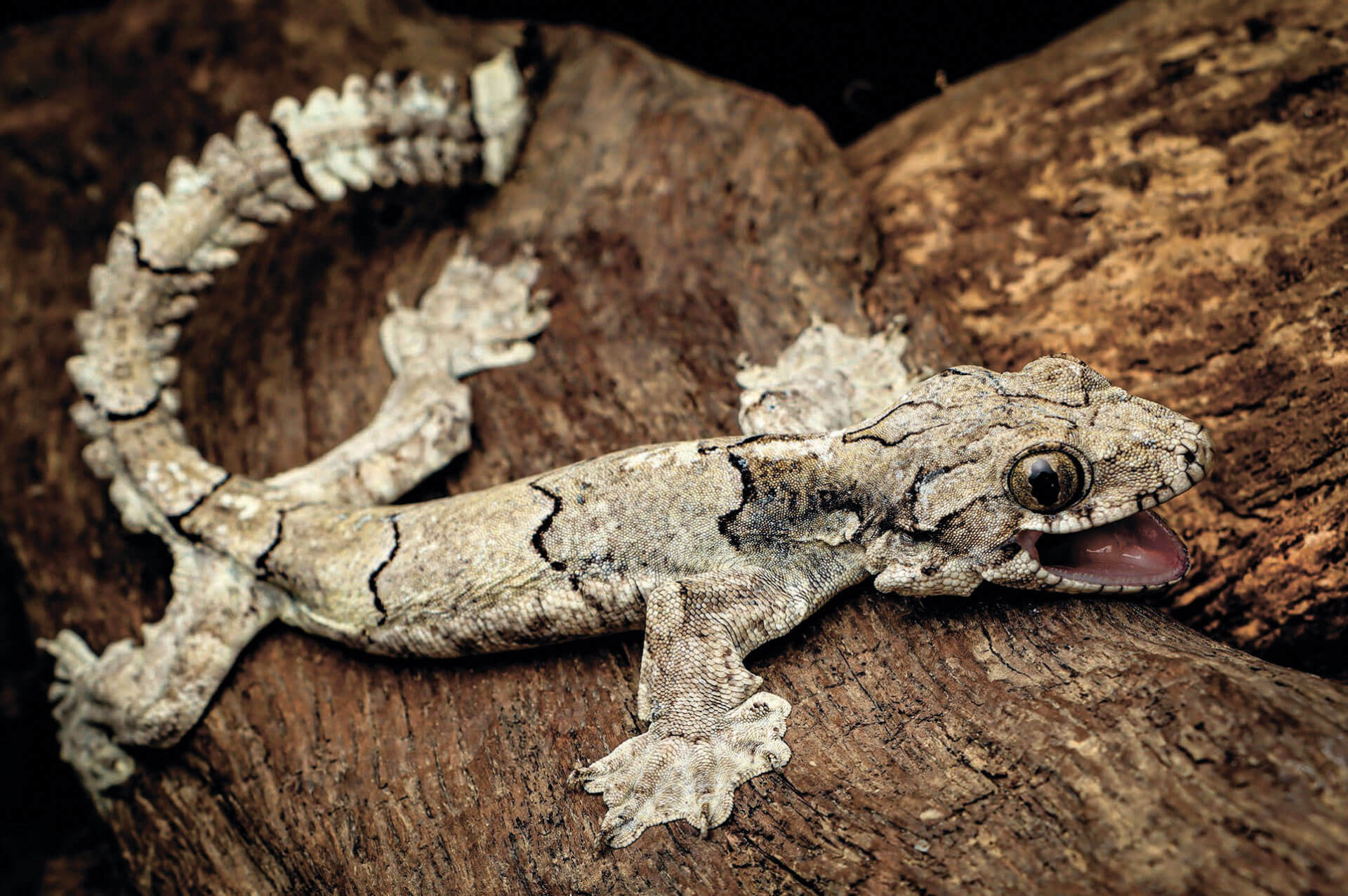
Now, we’ll introduce you to another reptile: The Mizoram’s parachute gecko. Gekko mizoramensis is named after the state in northern India where it was found. Although it was collected more than two decades ago, recent research revealed the differences in regard to its relatives.
These geckos have the ability to “fly” – or rather glide – in the air, thanks to their webbed feet and pieces of skin hanging from their bodies that expand with the air, like a parachute, to reduce the speed at which they fall from above. They’re also specialists in camouflage. This combination of talents provides protection for these small reptiles.
6. Black River Torrent Frog (Hyloscirtus tolkieni)
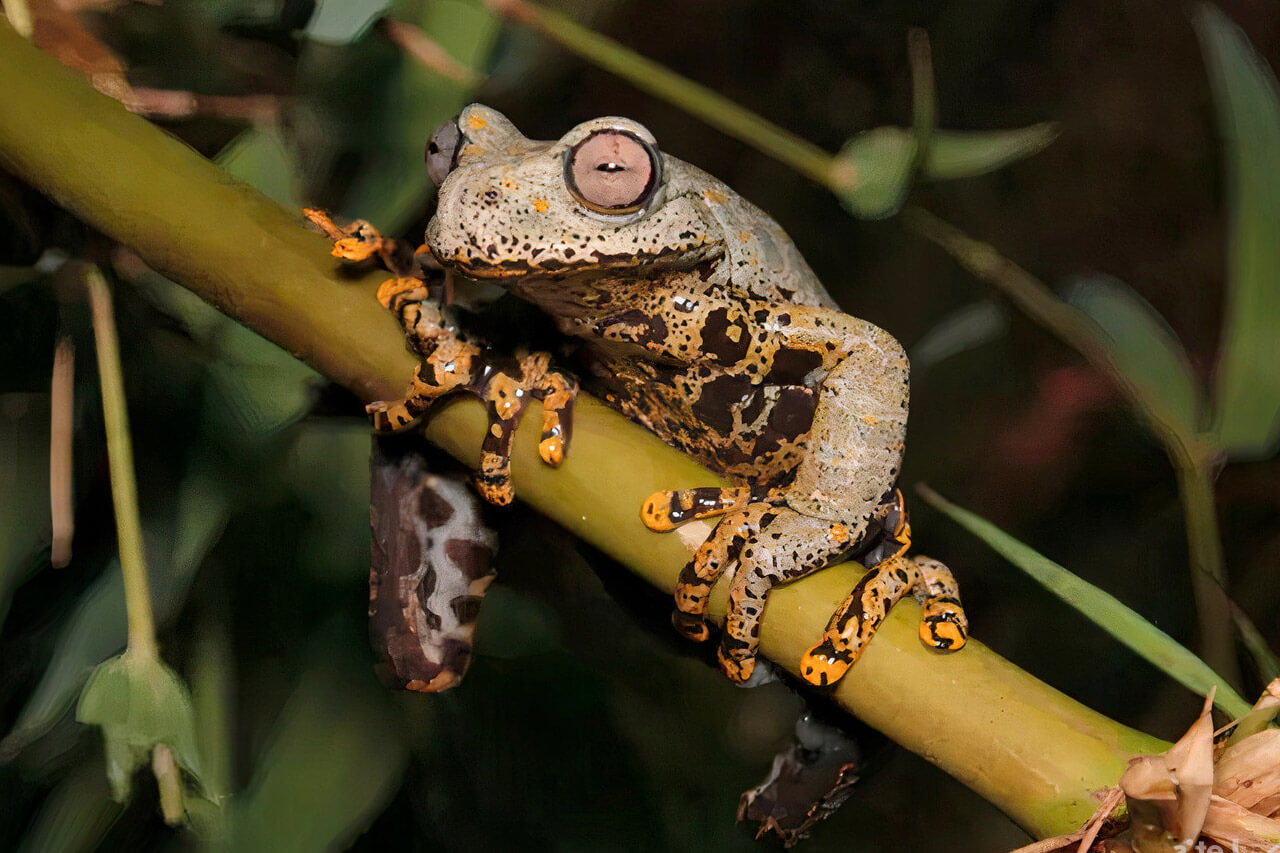
A new tree frog belonging to the genus Hyloscirtus was discovered in the Río Negro-Sopladora National Park, located in southeastern Ecuador. The specific epithet of its scientific name – Tolkieni– pays homage to the writer and philologist, Ronald Reuel Tolkien, author of works such as The Lord of the Rings and The Hobbit.
According to the study of the finding, which was published in the journal ZooKeys, the specimen is distinguished by the dermal stripes on the toes of its front and hind legs of its body, which measures 2.5 inches in length.
Regarding its coloration, the specimen studied exhibits a pattern with a pale background color and dark markings in the following areas:
- Dorsal
- Lateral
- Ventral
It differs from other frogs of its genus thanks to its grayish dorsum with black speckles and yellow spots.
7. Antarctic strawberry feather star (Promachocrinus fragarius)
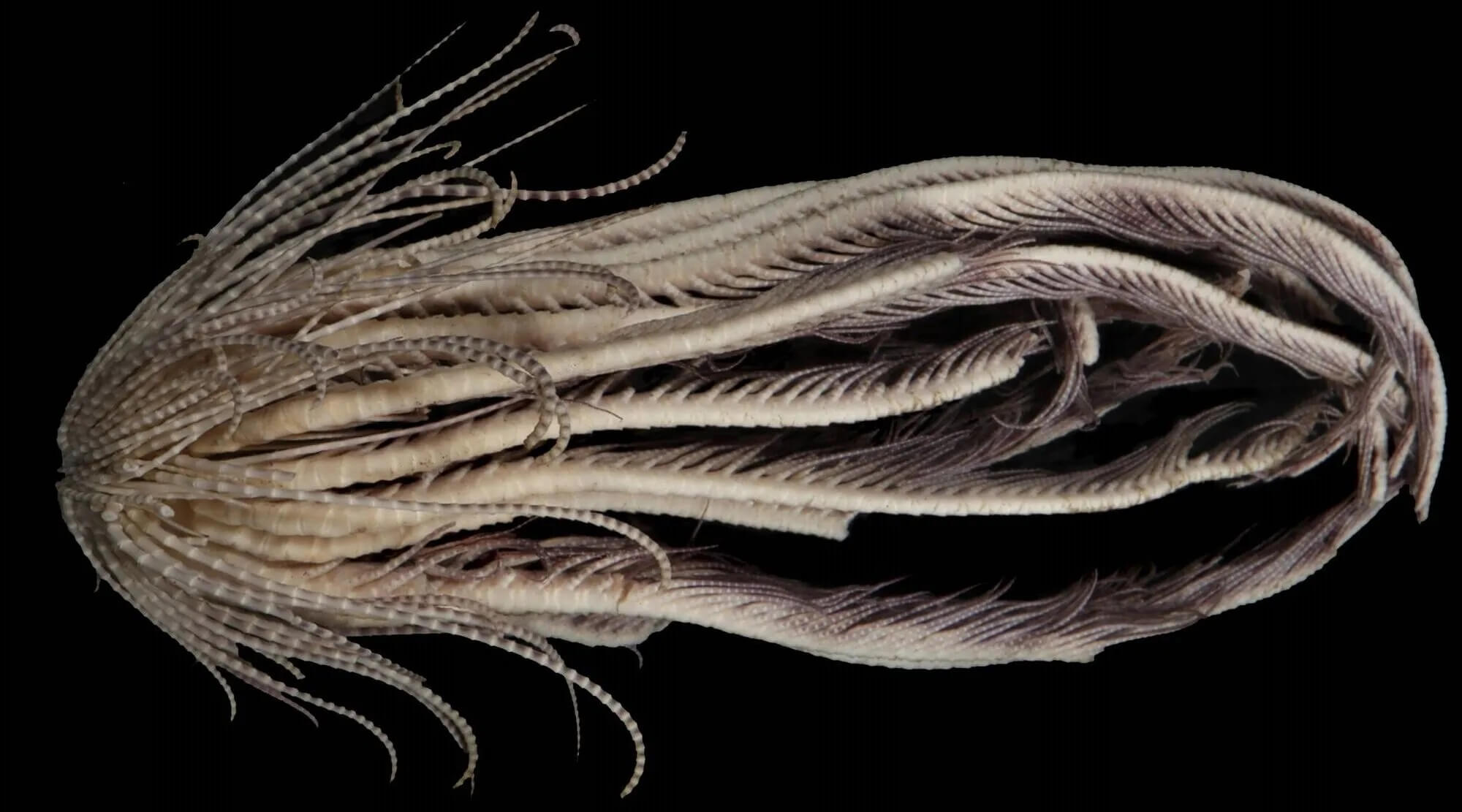
This new species of strawberry feather star, discovered in 2023 in Antarctica, has 20 arms. It belongs to the phylum Echinodermata and class Crinoidea. This curious invertebrate inhabits depths ranging from 65 to 6560 feet.
According to the study published in the journal Invertebrate Systematics prior to this finding, Promachocrinus kerguelensis was considered to be the only species of sea lily.
Srini’s bent-winged bat (Miniopterus srinii)
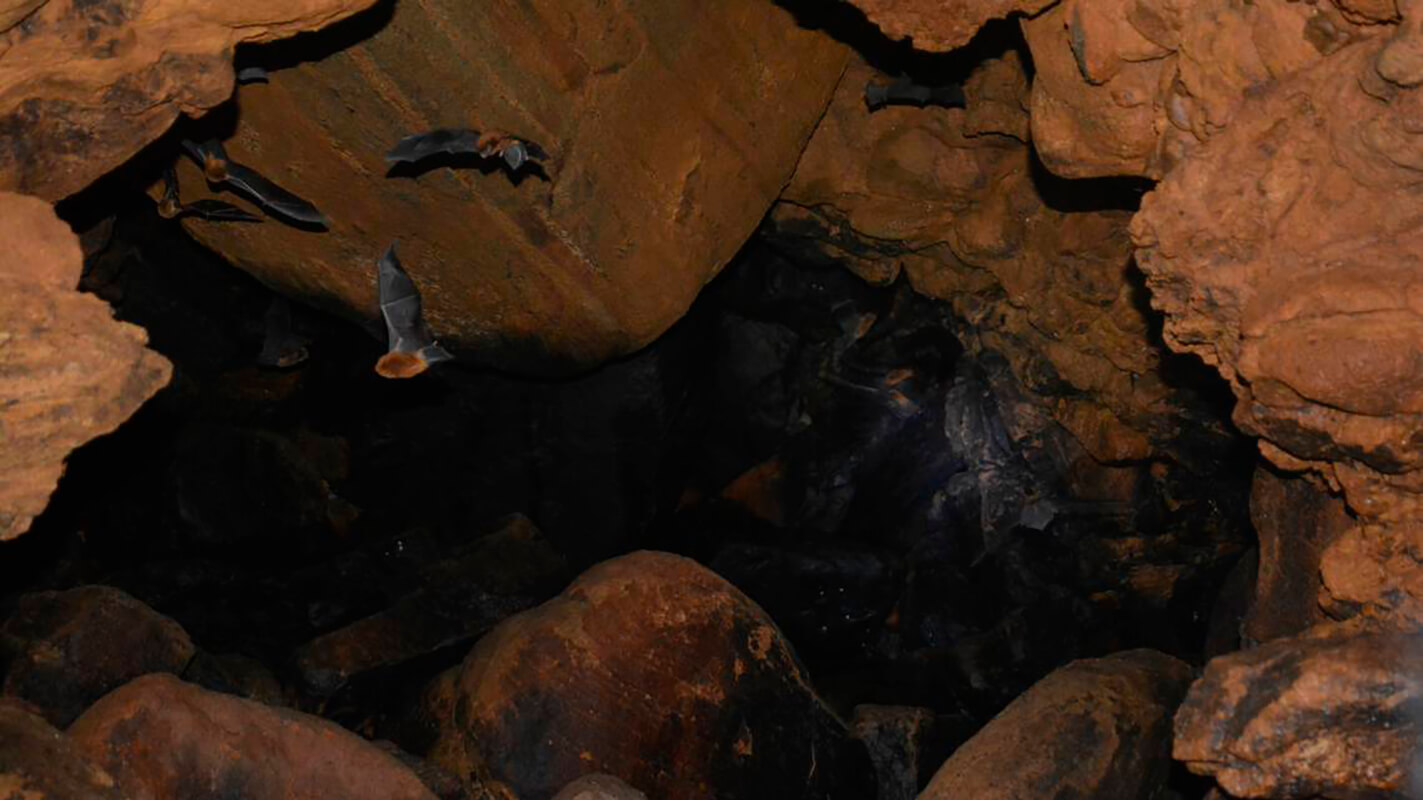
In a cave in the jungles of the Western Ghats of southern Karnataka, India, zoologist Bhargavi Srinivasulu and her son, researcher Aditya Srinivasulu, found a new species of bat.
The study detailing the discovery was published in the journal Zootaxa. It states that the bat found bears similarities to Miniopterus pusillus. However, the new cryptic species -with few differences that set it apart from others of its genus- is distinguished by the following characteristics:
- Larger size
- Echolocation call parameters
- Different measurements of the skull and teeth.
The protagonists of the find emphasize that the new species lives in the Western Ghats with Miniopterus phillipsi and Miniopterus pusillus.
9. Lavender dartfish (Nemateleotris lavandula)
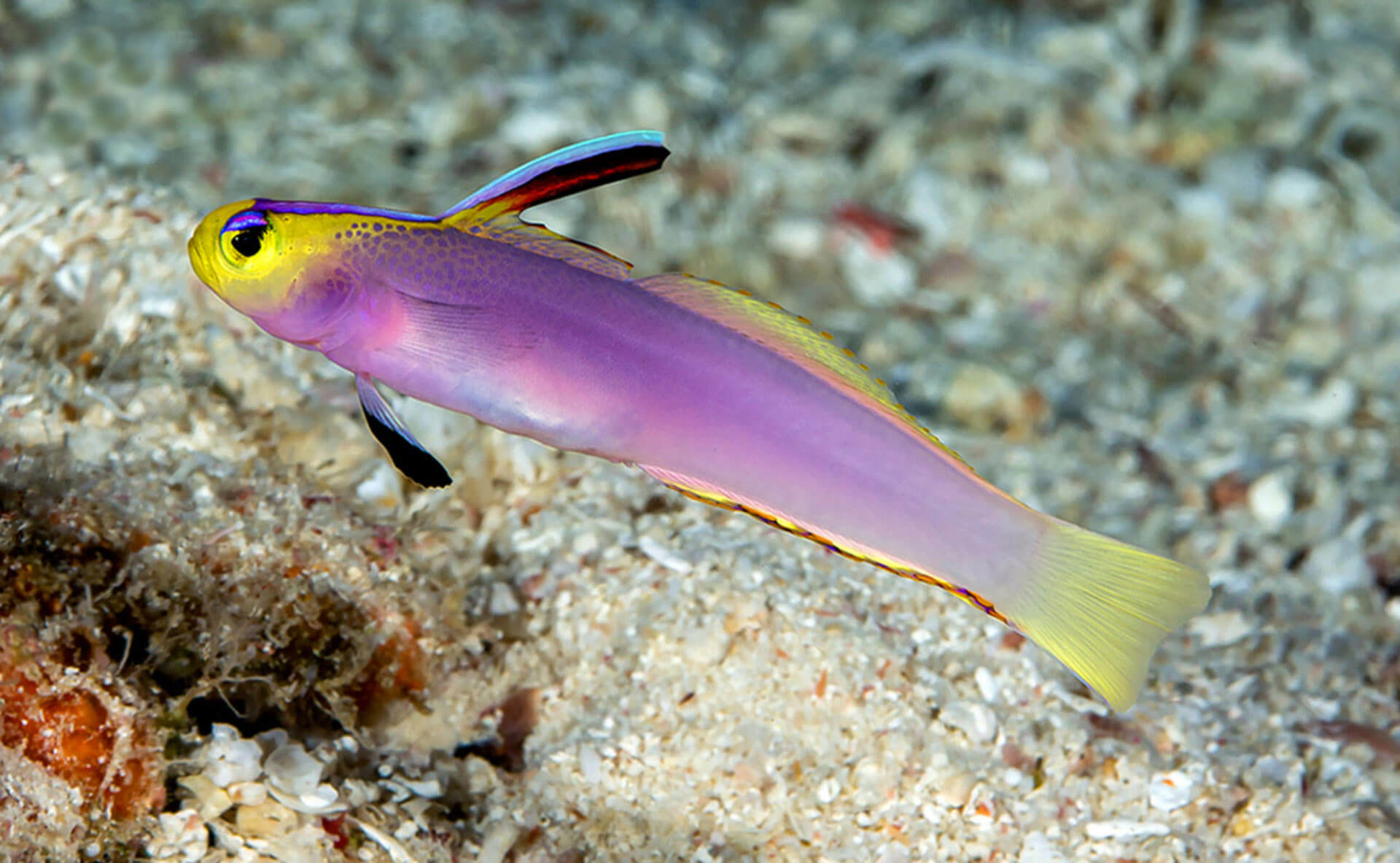
Among the animals discovered in 2023 is the lavender dartfish. It inhabits the Pacific Ocean, to be more precise, close to the substrate – in the surroundings or on coral reefs – at depths ranging from 20 to 330 feet. It exhibits vivid coloration: A yellow color on its face and shades between lavender and lilac on the body.
According to the study reported in the Raffles Bulletin of Zoology, the size of this fish doesn’t usually exceed 2.75 inches in total length. Its morphology is elongated and somewhat compressed.
The diet of the lavender dartfish is dominated by plankton.
10. Isoxya manangona spider (Isoxya manangona)
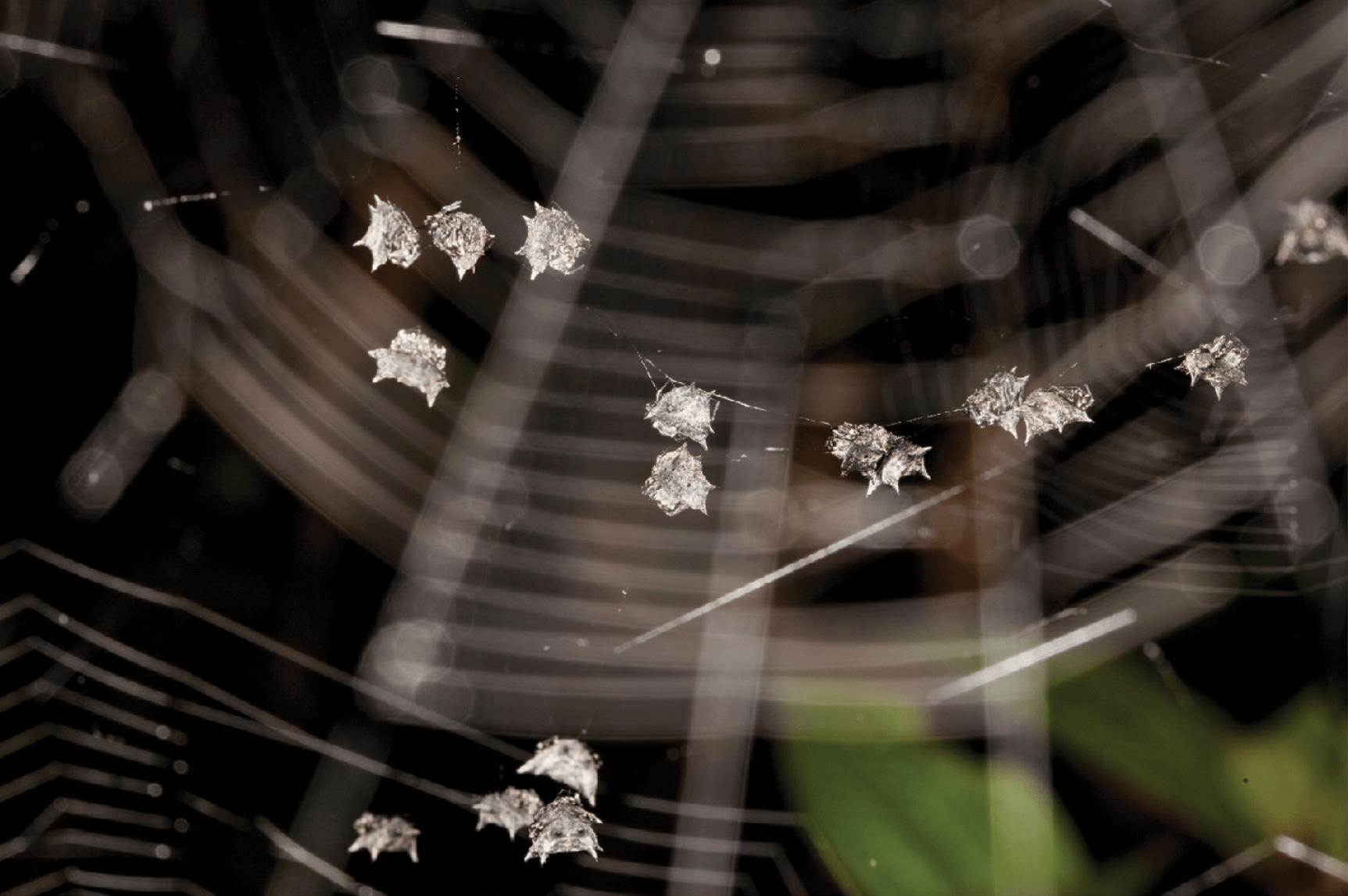
A new species of kite spider, named Isoxya manangona, inhabits Madagascar. Because of its peculiar mating aggregations, the specific epithet of the scientific name – manangona – refers to the action of “to gather or aggregate” in the Malagasy language.
The publication concerning this discovery, published in Insect Systematics and Diversity, specifies the finding of “single colonies,” composed of up to 41 networks of interconnected females belonging to a single court, with up to 38 males, integrated in a central line. In both genders, these are adults.
The researchers indicate that no signs of aggression were observed among the males.
11. Box jellyfish Tripedalia maipoensis
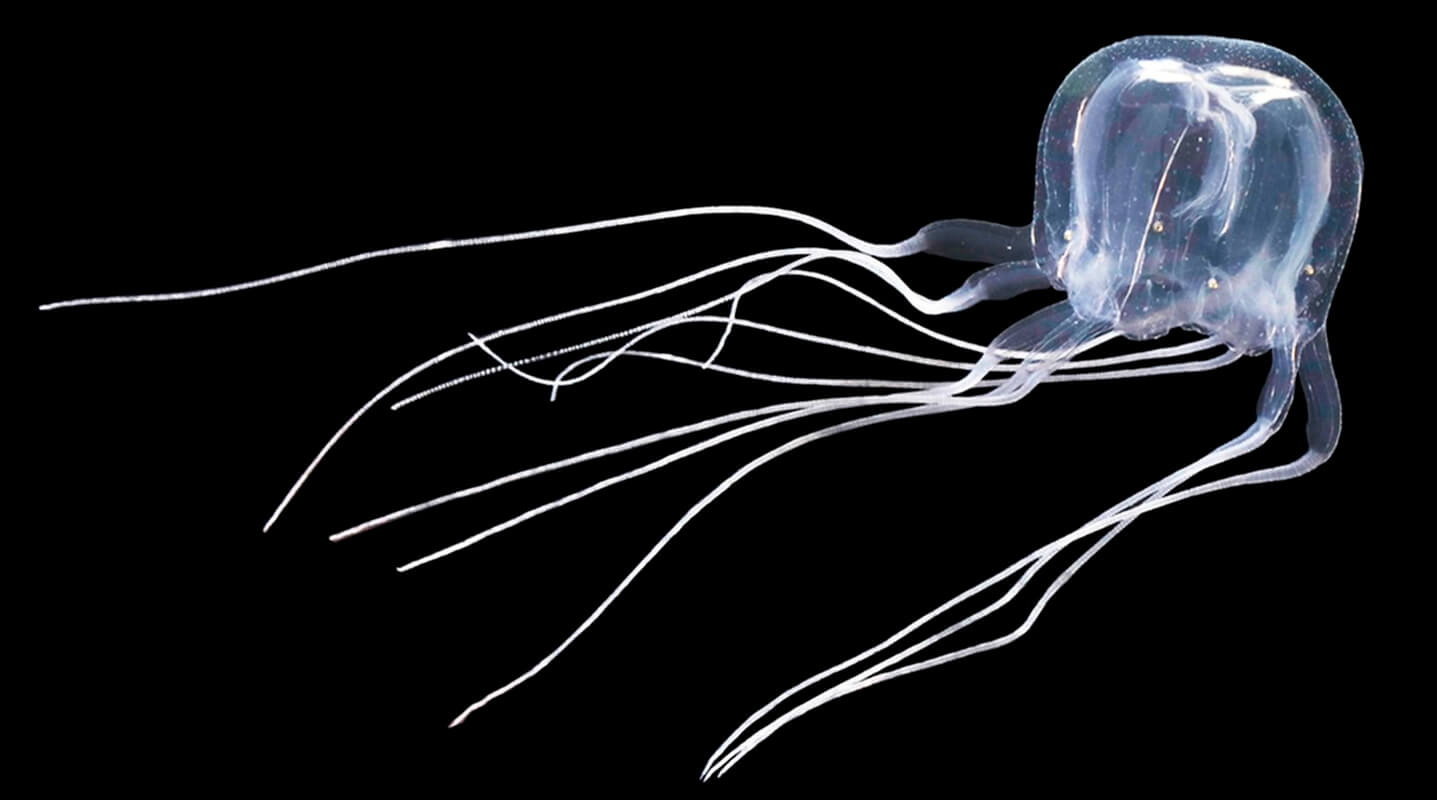
A new species of jellyfish was found in the Mai Po Nature Reserve, located northwest in Hong Kong. It possesses 24 eyes: Six in each of the four ropelia (sensory structures). The study published in Zoological Studies claims that Tripedalia maipoensis has a transparent, cube-shaped bell with rounded edges.
In the class Cubozoa, to which the box jellyfish Mai Po belongs, some of the most venomous marine species on the planet are grouped.
In addition, the Tripedalia maipoensis exhibits three pedalia (pedal-shaped structure at the base of the tentacles) at the corners of the bell, as well as a velarium (membranous tissue cover or sheet), which has bifurcated canals.
12. Moles (Talpa hakkariensis and Talpa davidiana tatvanensis)
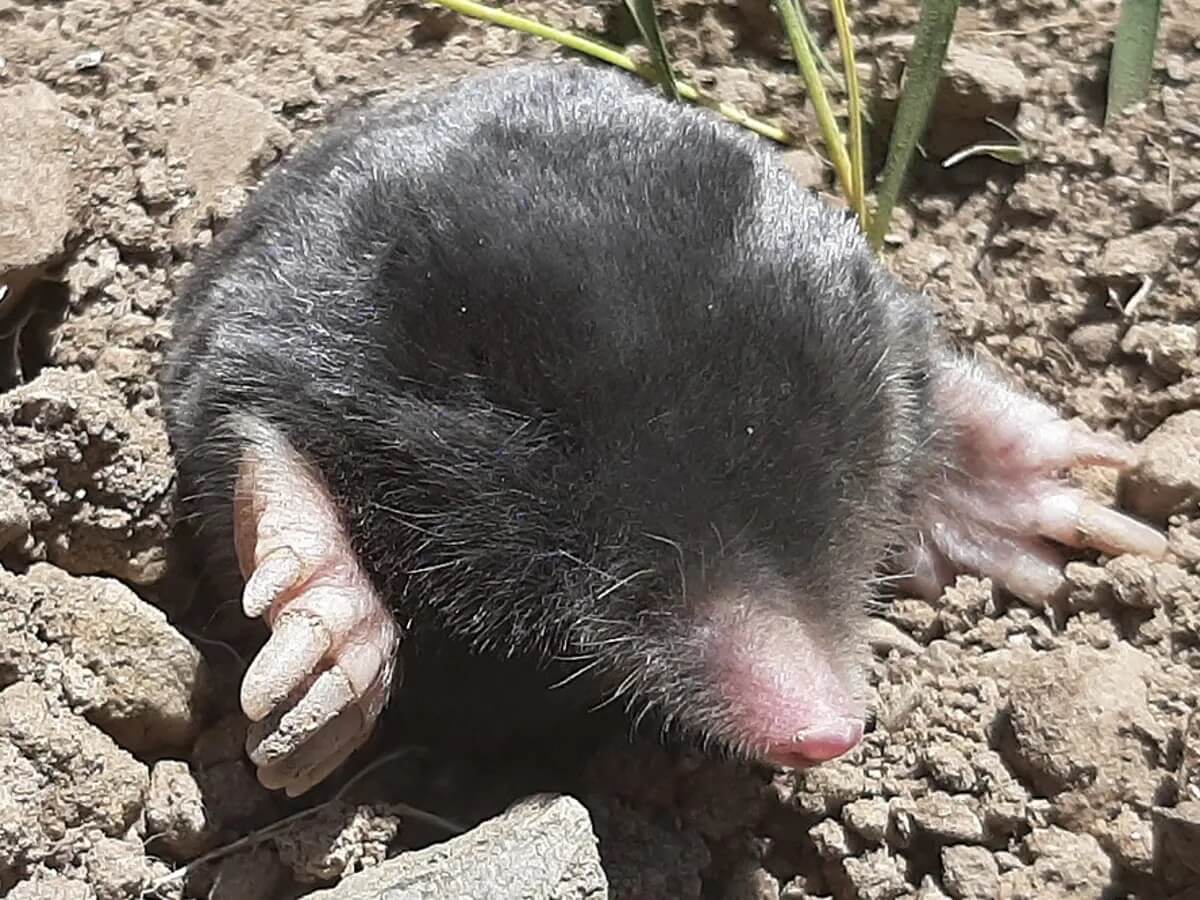
Two new mole species join the list of animals discovered in 2023. An article reported in the Zoological Journal of the Linnean Society explains that the double find was recorded in the mountains of eastern Turkey, where these subterranean mammals live.
These species are believed to have lived for 3 million years.
Talpa hakkariensis was found in the Hakkari region, while Talpa davidiana tatvanenesis was discovered in the vicinity of Bitlis. The latter was cataloged as a subspecies of Talpa davidiana, first described in 1884.
13. Leaf-tailed gecko (Phyllurus fimbriatus)
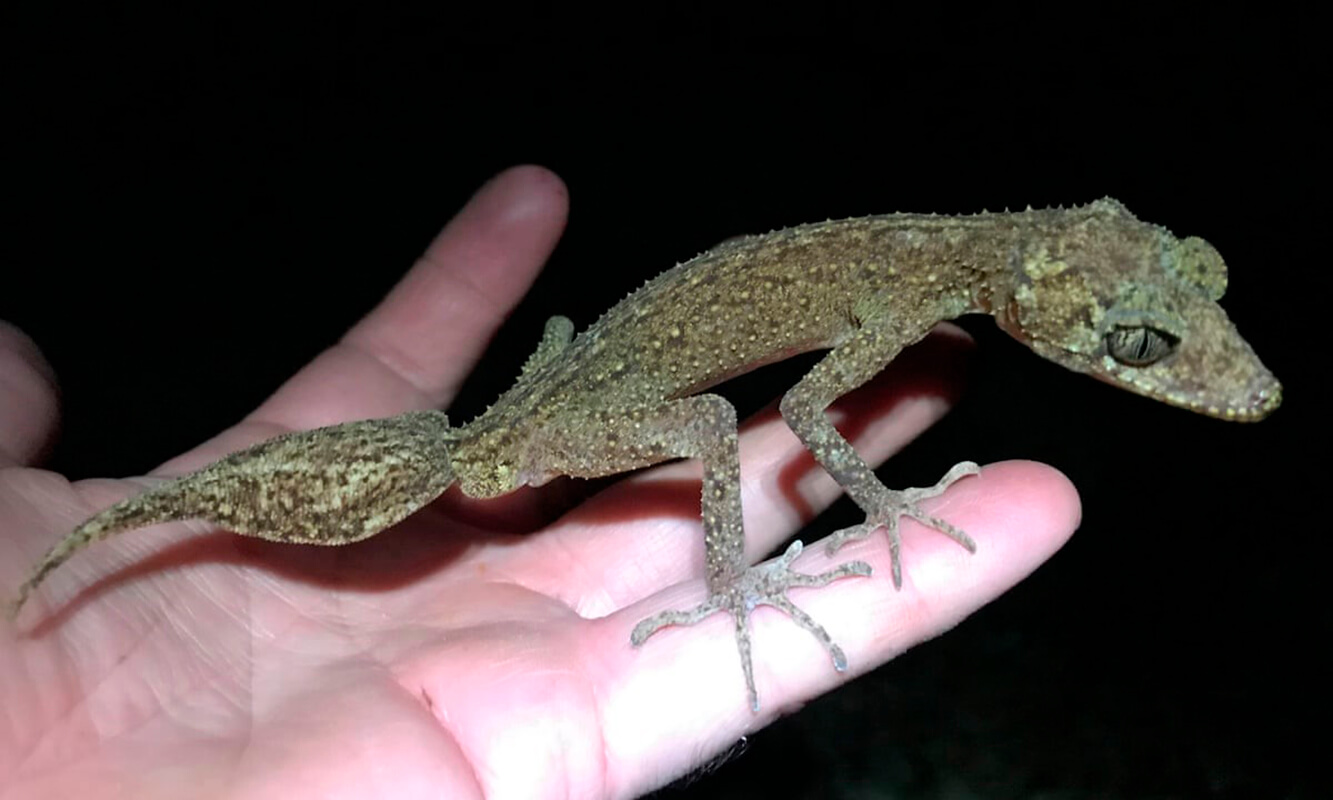
This new species of gecko inhabits the stacked rocks of the rainforest on Scawfell Island, Australia. Specimens are found on the surface of these rocks at night and hide in their depths in the daytime.
A study published in the journal Zootaxa about Phyllurus fimbriatus describes its morphology. This species is characterized by a leaf-shaped flared tail and a pronounced snout. In addition, its body size ranges from 4 to 4.5 inches in length.
Many species are still to be discovered
After this brief journey through the animals discovered in 2023, you might think that we already know all the existing species; however, nothing could be further from the truth. The truth is that new discoveries are being made every day in regions of the planet about which we still know very little.
Nowadays, new research techniques make it possible to clearly differentiate even the most similar specimens and, thanks to them, we can better understand the biodiversity of our amazing world. A space full of a variety of shapes, colors, sizes, and behaviors, but from which, without a doubt, we have a great deal to learn.
There are about 1,499,858 species in the Animal kingdom, grouped into 34 phyla, 110 classes, 686 orders, 9501 families, and 160,271 genera. And although the numbers may seem impressive, you may be surprised to know that new species are added to the list every year. Do you want to discover some of the animals that were discovered in 2023?
In 2022, researchers at the Natural History Museum in London described 351 new creatures, including beetles, moths, worms, bumblebees, wasps, reptiles, amphibians, and fish. Below, we’ll bring you 14 amazing specimens that humans have named for the first time this year. Let’s get to know them in the following list.
1. Snail-eating snake (Pareas baiseensis)

Among the animals discovered in 2023 is a snake belonging to the family Pareidae, which includes four genera, including Pareas, with the greatest diversity of specimens. Its discovery took place on the Asian continent, in the Guangxi Zhuang Autonomous Region of China.
This event was published in the journal Animals, in July 2023. The habitat of the new species is the subtropical evergreen broadleaf forest, between 750 and 790 meters above sea level, where four individuals (one male and three young) were found.
The morphological differences between the species that make up the genus Pareas are very subtle, so they’re difficult to distinguish from one another. Because of this, molecular analyses are indispensable for this purpose.
The snake Pareas baiseensis has a slender body with an elongated head and a round snout. The dorsal part is yellowish brown, with dark brown spots, while the ventral region is lighter, with some black speckles. It has irregular black bands on the sides. Also, it has a greater number of ventral and subcaudal scales than other relatives.
2. Patkai green tree frog (Gracixalus patkaiensis)

Gracixalus patkaiensis is a species of frog that belongs to the family Rhacophoridae, which was discovered in an evergreen forest in northeastern India at an elevation of 2126 feet above sea level.
The evidence for this discovery, published in the journal Vertebrate Zoology was based on the following characteristics:
- Physical
- Acoustic
- Molecular
This tree frog has a pointed snout and a slender green body with brown spots of different sizes. Its limbs are also elongated, and it doesn’t have membranes on its toes. It’s also very small, measuring between 23.6 and 26.5 millimeters in length.
It’s the first rhacophoridae frog found in India, and the word patkaiensis refers to the Patkai hill range. Therefore, the popular name suggested by researchers is Patkai green tree frog.
3. Aritana’s brown four-eyed possum (Metachirus aritanai)

Another animal discovered in 2023 is a brown four-eyed opossum or jupati. It belongs to the genus Metachirus, which consisted of only one species and five subspecies, although during the last few years, it has been analyzed in greater depth to clarify its taxonomy.
Therefore, a study published in the journal Mammalia describes a new specimen from the Serra de Carajás, in Brazil, with the scientific name of M. aritanai, in honor of an indigenous leader of the Yawalapiti ethnic group, named Aritana.
This opossum is found in the interfluve of the Xingu and Trocantis rivers, but its exact distribution isn’t fully defined. Among its characteristics are the following:
- A cream-colored ventral area
- A broader and more robust head
- Light brown dorsal coloration mottled with gold.
They were given the name four-eyed opossums thanks to some spots present above their eyes that, in this case, are cream-colored.
4. One of the most fascinating animals discovered in 2023: The Saurona triangula butterfly

Named after the villain of the Lord of the Rings trilogy, Sauron, we have one of the insect-like animals discovered in 2023. It’s the butterfly Saurona triangula, found in the lowland rainforest of the southeastern Amazon in South America.
This species has brown wings with five black ocelli on each side. These are circular with large central silver pupils surrounded by orange scales.
Therefore, the name of this animal is thanks to its resemblance to the fiery eye of Sauron.
A researcher at the Natural History Museum in London gave the name to the genus, which has only two species: S. triangula and its relative S. aurigera. It’s also important to mention that there’s little data on its biology, as neither the immature stages nor the host plants are known. The study was published in the journal Systematic Entomology.
5. Mizoram’s parachute gecko (Gekko mizoramensis)

Now, we’ll introduce you to another reptile: The Mizoram’s parachute gecko. Gekko mizoramensis is named after the state in northern India where it was found. Although it was collected more than two decades ago, recent research revealed the differences in regard to its relatives.
These geckos have the ability to “fly” – or rather glide – in the air, thanks to their webbed feet and pieces of skin hanging from their bodies that expand with the air, like a parachute, to reduce the speed at which they fall from above. They’re also specialists in camouflage. This combination of talents provides protection for these small reptiles.
6. Black River Torrent Frog (Hyloscirtus tolkieni)

A new tree frog belonging to the genus Hyloscirtus was discovered in the Río Negro-Sopladora National Park, located in southeastern Ecuador. The specific epithet of its scientific name – Tolkieni– pays homage to the writer and philologist, Ronald Reuel Tolkien, author of works such as The Lord of the Rings and The Hobbit.
According to the study of the finding, which was published in the journal ZooKeys, the specimen is distinguished by the dermal stripes on the toes of its front and hind legs of its body, which measures 2.5 inches in length.
Regarding its coloration, the specimen studied exhibits a pattern with a pale background color and dark markings in the following areas:
- Dorsal
- Lateral
- Ventral
It differs from other frogs of its genus thanks to its grayish dorsum with black speckles and yellow spots.
7. Antarctic strawberry feather star (Promachocrinus fragarius)

This new species of strawberry feather star, discovered in 2023 in Antarctica, has 20 arms. It belongs to the phylum Echinodermata and class Crinoidea. This curious invertebrate inhabits depths ranging from 65 to 6560 feet.
According to the study published in the journal Invertebrate Systematics prior to this finding, Promachocrinus kerguelensis was considered to be the only species of sea lily.
Srini’s bent-winged bat (Miniopterus srinii)

In a cave in the jungles of the Western Ghats of southern Karnataka, India, zoologist Bhargavi Srinivasulu and her son, researcher Aditya Srinivasulu, found a new species of bat.
The study detailing the discovery was published in the journal Zootaxa. It states that the bat found bears similarities to Miniopterus pusillus. However, the new cryptic species -with few differences that set it apart from others of its genus- is distinguished by the following characteristics:
- Larger size
- Echolocation call parameters
- Different measurements of the skull and teeth.
The protagonists of the find emphasize that the new species lives in the Western Ghats with Miniopterus phillipsi and Miniopterus pusillus.
9. Lavender dartfish (Nemateleotris lavandula)

Among the animals discovered in 2023 is the lavender dartfish. It inhabits the Pacific Ocean, to be more precise, close to the substrate – in the surroundings or on coral reefs – at depths ranging from 20 to 330 feet. It exhibits vivid coloration: A yellow color on its face and shades between lavender and lilac on the body.
According to the study reported in the Raffles Bulletin of Zoology, the size of this fish doesn’t usually exceed 2.75 inches in total length. Its morphology is elongated and somewhat compressed.
The diet of the lavender dartfish is dominated by plankton.
10. Isoxya manangona spider (Isoxya manangona)

A new species of kite spider, named Isoxya manangona, inhabits Madagascar. Because of its peculiar mating aggregations, the specific epithet of the scientific name – manangona – refers to the action of “to gather or aggregate” in the Malagasy language.
The publication concerning this discovery, published in Insect Systematics and Diversity, specifies the finding of “single colonies,” composed of up to 41 networks of interconnected females belonging to a single court, with up to 38 males, integrated in a central line. In both genders, these are adults.
The researchers indicate that no signs of aggression were observed among the males.
11. Box jellyfish Tripedalia maipoensis

A new species of jellyfish was found in the Mai Po Nature Reserve, located northwest in Hong Kong. It possesses 24 eyes: Six in each of the four ropelia (sensory structures). The study published in Zoological Studies claims that Tripedalia maipoensis has a transparent, cube-shaped bell with rounded edges.
In the class Cubozoa, to which the box jellyfish Mai Po belongs, some of the most venomous marine species on the planet are grouped.
In addition, the Tripedalia maipoensis exhibits three pedalia (pedal-shaped structure at the base of the tentacles) at the corners of the bell, as well as a velarium (membranous tissue cover or sheet), which has bifurcated canals.
12. Moles (Talpa hakkariensis and Talpa davidiana tatvanensis)

Two new mole species join the list of animals discovered in 2023. An article reported in the Zoological Journal of the Linnean Society explains that the double find was recorded in the mountains of eastern Turkey, where these subterranean mammals live.
These species are believed to have lived for 3 million years.
Talpa hakkariensis was found in the Hakkari region, while Talpa davidiana tatvanenesis was discovered in the vicinity of Bitlis. The latter was cataloged as a subspecies of Talpa davidiana, first described in 1884.
13. Leaf-tailed gecko (Phyllurus fimbriatus)

This new species of gecko inhabits the stacked rocks of the rainforest on Scawfell Island, Australia. Specimens are found on the surface of these rocks at night and hide in their depths in the daytime.
A study published in the journal Zootaxa about Phyllurus fimbriatus describes its morphology. This species is characterized by a leaf-shaped flared tail and a pronounced snout. In addition, its body size ranges from 4 to 4.5 inches in length.
Many species are still to be discovered
After this brief journey through the animals discovered in 2023, you might think that we already know all the existing species; however, nothing could be further from the truth. The truth is that new discoveries are being made every day in regions of the planet about which we still know very little.
Nowadays, new research techniques make it possible to clearly differentiate even the most similar specimens and, thanks to them, we can better understand the biodiversity of our amazing world. A space full of a variety of shapes, colors, sizes, and behaviors, but from which, without a doubt, we have a great deal to learn.
All cited sources were thoroughly reviewed by our team to ensure their quality, reliability, currency, and validity. The bibliography of this article was considered reliable and of academic or scientific accuracy.
- Agnarsson, I., Starrett, J., Babbitz, Z., Bond, J. E., Gregorič, M., Christian Raberahona, O., … & Kuntner, M. (2023). Discovery and Genetic Characterization of Single Cohort Adult Colonies With Male Aggregations, and Preliminary Evidence for Lekking in a Malagasy Kite Spider (Isoxya, Gasteracanthinae). Insect Systematics and Diversity, 7(1), 3.
- Ashworth, J. (2023). New flying gecko species reveals hidden biodiversity of northern India. Natural History Museum. Consultado el 04 de septiembre de 2023. https://www.nhm.ac.uk/discover/news/2023/june/new-flying-gecko-species-reveals-hidden-biodiversity-northern-india.html
- Ashworth, J. (2023). New group of butterflies named after Lord of the Rings villain Sauron. Natural History Museum. Consultado el 04 de septiembre de 2023. https://www.nhm.ac.uk/discover/news/2023/may/new-group-butterflies-named-after-lord-of-the-rings-villain-sauron.html
- Boruah, B., Deepak, V., Patel, N., Jithin, V., Yomcha, T., Das, A. (2023). A new species of green tree frog of the genus Gracixalus (Anura: Rhacophoridae) from the evergreen forest of Northeast India. Vertebrate Zoology, 73, 557-574. https://vertebrate-zoology.arphahub.com/articles.php?id=98444
- Davis, J. (2022). Museum scientists described 351 new species in 2022. Natural History Museum. Consultado el 04 de septiembre de 2023. https://www.nhm.ac.uk/discover/news/2022/december/natural-history-museum-scientists-describe-351-new-species-in-2022.html
- Encyclopedia of Life (s.f.). Cnidarians. Consultado el 21 de septiembre de 2023. https://eol.org/pages/1745
- Espeland, M., Nakahara, S., Zacca, T., Barbosa, E., Huertas, B., Marín, M., Lamas, G., Benmesbah, M., Brevignon, C., Casagrande, M., … & Willmott, K. (2023). Combining target enrichment and Sanger sequencing data to clarify the systematics of the diverse Neotropical butterfly subtribe Euptychiina (Nymphalidae, Satyrinae). Systematic Entomology, 48(4), 498-570. https://resjournals.onlinelibrary.wiley.com/doi/10.1111/syen.12590
- Gong, Y., Wu, J., Huang, S., Xu, Y., Yang, D., Liu, Y., Liang, S., Lee, P. (2023). A New Species of Pareas (Squamata, Pareidae) from Guangxi Province, China. Animals, 13(13), 1-15. https://www.mdpi.com/2076-2615/13/13/2233
- Gündüz, İ., Demirtaş, S., Silsüpür, M., Özmen, M., Polly, P. D., & Bilton, D. T. (2023). Notes from the Anatolian underground: two new mole taxa from Eastern Turkey, together with a revised phylogeny of the genus Talpa (Mammalia: Eulipotyphla: Talpidae). Zoological Journal of the Linnean Society, zlad049. https://doi.org/10.1093/zoolinnean/zlad049
- McLaughlin, E. L., Wilson, N. G., & Rouse, G. W. (2023). Resolving the taxonomy of the Antarctic feather star species complex Promachocrinus ‘kerguelensis’(Echinodermata: Crinoidea). Invertebrate Systematics, 37(7), 498-527. https://www.publish.csiro.au/IS/IS22057
- Miranda, C., Nunes, M., Fabrício Machado, A., Farias, I., Menezes, F., Ardente, N., Dos Santos-Filho, M., Bredin, Y. & da Silva, M. (2023). A new species of jupati, genus Metachirus Burmeister 1854 (Didelphimorphia, Didelphidae) for the Brazilian Amazon. Mammalia, 87(2), 172-189. https://repositorio.inpa.gov.br/handle/1/39033
- Sánchez-Nivicela, J. C., Falcón-Reibán, J. M., & Cisneros-Heredia, D. F. (2023). A new stream treefrog of the genus Hyloscirtus (Amphibia, Hylidae) from the Río Negro-Sopladora National Park, Ecuador. ZooKeys, 1141, 75. https://www.ncbi.nlm.nih.gov/pmc/articles/PMC10208809/
- Srinivasulu, B., & Srinivasulu, A. (2023). A new species of the Miniopterus australis species complex (Chiroptera: Miniopteridae) from the Western Ghats, India. Zootaxa, 5296(2), 233-249. https://www.mapress.com/zt/article/view/zootaxa.5296.2.5
- Sun, Y., Tsui, J. H. Y., Wong, R. T. H., Cheung, R. N. C., Ng, M. K. P., Or, C. K., & Qiu, J. W. (2023). A new species of box jellyfish (Cnidaria: Tripedaliidae: Tripedalia) from Hong Kong, China. Zoological Studies, 62. https://zoolstud.sinica.edu.tw/Journals/62/62-17.html
- Tea, Y. & Larson, H. (2023). Synopsis of the ptereleotrine goby genus Nemateleotris, with description of a new species from the western and central Pacific Ocean (Teleostei: Gobiidae). Raffles Bulletin of Zoology, 71: 248–266. https://lkcnhm.nus.edu.sg/wp-content/uploads/sites/10/2023/03/RBZ-2023-0019.pdf
This text is provided for informational purposes only and does not replace consultation with a professional. If in doubt, consult your specialist.








